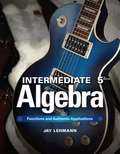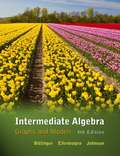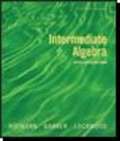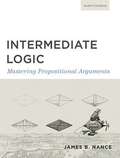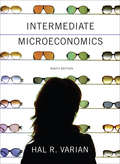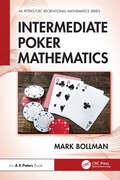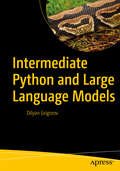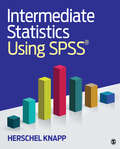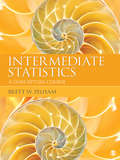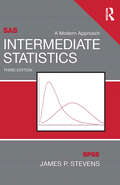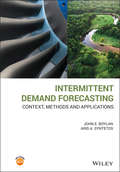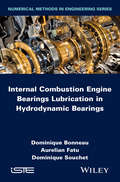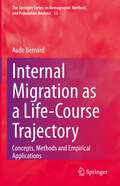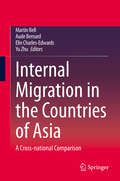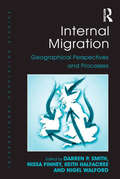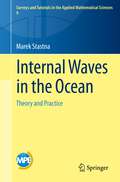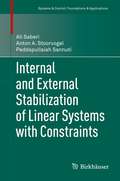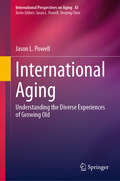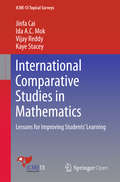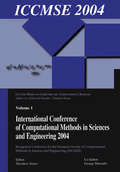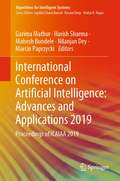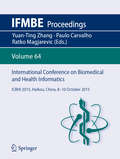- Table View
- List View
Intermediate Algebra: Concepts with Applications
by Charles P. McKeagueThis intermediate text gives practical applications for topics learned in Introductory Algebra. Students can expect a more rigorous approach to algebraic fundamentals. Topics include, but are not limited to: linear equations; exponents and polynomials; rational expressions; quadratic functions; and exponential and logarithmic functions.
Intermediate Algebra: Functions & Authentic Applications
by Jay LehmannIn this course, you will learn not only more about algebra but also how to apply algebra to describe and make predictions about authentic situations.
Intermediate Algebra: Graphs and Models (4th edition)
by Marvin L. Bittinger David J. Ellenbogen Barbara L. JohnsonDrawing examples from business, chemistry, and physics, this textbook walks through graphical and algebraic methods for solving linear equations, inequalities, and polynomials, as well as rational, radical, quadratic, exponential, and logarithmic equations. The second edition moves the conic sections material to an appendix and adds a section on factoring the sums and differences of cubes.
Intermediate Algebra: With Applications
by Richard N. Aufmann Vernon C. Barker Joanne S. LockwoodIntended for developmental math courses in intermediate algebra, this text retains the hallmark features that have made the Aufmann texts market leaders: an interactive approach in an objective-based framework: a clear writing style, and an emphasis on problem-solving strategies. The acclaimed Aufmann Interactive Method, allows students to try a skill as it is introduced with matched-pair examples, offering students immediate feedback, reinforcing the concept, identifying problem areas, and, overall, promoting student success.
Intermediate Logic: Mastering Propositional Arguments (Third Edition)
by James B. NanceThis text is designed as a continuation to Introductory Logic, which I co-authored with Douglas Wilson. Together, these two textbooks should provide sufficient material for a complete course in elementary logic.
Intermediate Mathematics: A Student Guide
by K12A comprehensive student guide through Intermediate Mathematics.
Intermediate Microeconomics: A Modern Approach Ninth Edition
by Hal R. VarianRigorous and modern―the #1 text for Intermediate Microeconomics from the chief economist at Google. This best-selling text is still the most modern presentation of the subject. The Varian approach gives students tools they can use on exams, in the rest of their classes, and in their careers after graduation.
Intermediate Poker Mathematics (AK Peters/CRC Recreational Mathematics Series)
by Mark BollmanIntermediate Poker Mathematics provides a fascinating collection of mathematical questions set in the diverse world of poker. While it is absolutely possible that a poker player will glean some insight that will improve their skill at the table, this book is not intended primarily as a players’ strategy manual, but rather as a means of building up readers understanding of the mathematical concepts at play in the complex world of poker. Although the book is suitable for a general audience, it is formatted in the style of a textbook, with exercises included at the end of each chapter to help build understanding.Features Written in an approachable style with minimal mathematical prerequisites beyond basic algebra and arithmetic Replete with engaging exercises and examples Wide-ranging exploration of multiple forms of poker beyond the more well-known varieties.
Intermediate Python and Large Language Models
by Dilyan GrigorovHarness the power of Large Language Models (LLMs) to build cutting-edge AI applications with Python and LangChain. This book provides a hands-on approach to understanding, implementing, and deploying LLM-powered solutions, equipping developers, data scientists, and AI enthusiasts with the tools to create real-world AI applications. The journey begins with an introduction to LangChain, covering its core concepts, integration with Python, and essential components such as prompt engineering, memory management, and retrieval-augmented generation (RAG). As you progress, you&’ll explore advanced AI workflows, including multi-agent architectures, fine-tuning strategies, and optimization techniques to maximize LLM efficiency. The book also takes a deep dive into practical applications of LLMs, guiding you through the development of intelligent chatbots, document retrieval systems, content generation pipelines, and AI-driven automation tools. You&’ll learn how to leverage APIs, integrate LLMs into web and mobile platforms, and optimize large-scale deployments while addressing key challenges such as inference latency, cost efficiency, and ethical considerations. By the end of the book, you&’ll have gained a solid understanding of LLM architectures, hands-on experience with LangChain, and the expertise to build scalable AI applications that redefine human-computer interaction. What You Will Learn Understand the fundamentals of LangChain and Python for LLM development <span lang="EN-IN" style=
Intermediate Statistics Using SPSS
by Herschel KnappWhat statistical test should I use for this kind of data? How do I set up the data? What parameters should I specify when ordering the test? How do I interpret the results? Herschel Knapp′s friendly and approachable guide to real-world statistics answers these questions. Intermediate Statistics Using SPSS is not about abstract statistical theory or the derivation or memorization of statistical formulas–it is about applied statistics. With jargon-free language and clear processing instructions, this text covers the most common statistical functions–from basic to more advanced. Practical exercises at the conclusion of each chapter offer students an opportunity to process viable data sets, write cohesive abstracts in APA style, and build a thorough comprehension of the statistical process. Students will learn by doing with this truly practical approach to statistics.
Intermediate Statistics Using SPSS
by Herschel KnappWhat statistical test should I use for this kind of data? How do I set up the data? What parameters should I specify when ordering the test? How do I interpret the results? Herschel Knapp′s friendly and approachable guide to real-world statistics answers these questions. Intermediate Statistics Using SPSS is not about abstract statistical theory or the derivation or memorization of statistical formulas–it is about applied statistics. With jargon-free language and clear processing instructions, this text covers the most common statistical functions–from basic to more advanced. Practical exercises at the conclusion of each chapter offer students an opportunity to process viable data sets, write cohesive abstracts in APA style, and build a thorough comprehension of the statistical process. Students will learn by doing with this truly practical approach to statistics.
Intermediate Statistics: A Conceptual Course
by Brett W. PelhamIntermediate Statistics: A Conceptual Course is a student-friendly text for advanced undergraduate and graduate courses. It begins with an introductory chapter that reviews descriptive and inferential statistics in plain language, avoiding extensive emphasis on complex formulas. The remainder of the text covers 13 different statistical topics ranging from descriptive statistics to advanced multiple regression analysis and path analysis. Each chapter contains a description of the logic of each set of statistical tests or procedures and then introduces students to a series of data sets using SPSS, with screen captures and detailed step-by-step instructions. Students acquire an appreciation of the logic of descriptive and inferential statistics, and an understanding of which techniques are best suited to which kinds of data or research questions.
Intermediate Statistics: A Modern Approach, Third Edition
by James P. Stevens Keenan A. Pituch Tiffany A. WhittakerJames Stevens' best-selling text, Intermediate Statistics, is written for those who use, rather than develop, statistical techniques. Dr. Stevens focuses on a conceptual understanding of the material rather than on proving the results. SAS and SPSS are an integral part of each chapter. Definitional formulas are used on small data sets to provide conceptual insight into what is being measured. The assumptions underlying each analysis are emphasized and the reader is shown how to test the critical assumptions using SPSS or SAS. Printouts with annotations from SAS or SPSS show how to process the data for each analysis. The annotations highlight what the numbers mean and how to interpret the results. Numerical, conceptual, and computer exercises enhance understanding. Answers are provided for half of the exercises. The book offers comprehensive coverage of one-way, power, and factorial analysis of variance, repeated measures analysis, simple and multiple regression, analysis of covariance, and HLM. Power analysis is an integral part of the book. A computer example of real data integrates many of the concepts. Highlights of the Third Edition include: A new chapter on hierarchical linear modeling using HLM6 A CD containing all of the book's data sets New coverage of how to cross validate multiple regression results with SPSS and a new section on model selection (Chapter 6) More exercises in each chapter. Intended for intermediate statistics or statistics II courses taught in departments of psychology, education, business, and other social and behavioral sciences, a prerequisite of introductory statistics is required. An Instructor's Resource is available upon adoption. See www.researchmethodsarena.com .
Intermittent Demand Forecasting: Context, Methods and Applications
by John E. Boylan Aris A. SyntetosINTERMITTENT DEMAND FORECASTING The first text to focus on the methods and approaches of intermittent, rather than fast, demand forecasting Intermittent Demand Forecasting is for anyone who is interested in improving forecasts of intermittent demand products, and enhancing the management of inventories. Whether you are a practitioner, at the sharp end of demand planning, a software designer, a student, an academic teaching operational research or operations management courses, or a researcher in this field, we hope that the book will inspire you to rethink demand forecasting. If you do so, then you can contribute towards significant economic and environmental benefits. No prior knowledge of intermittent demand forecasting or inventory management is assumed in this book. The key formulae are accompanied by worked examples to show how they can be implemented in practice. For those wishing to understand the theory in more depth, technical notes are provided at the end of each chapter, as well as an extensive and up-to-date collection of references for further study. Software developments are reviewed, to give an appreciation of the current state of the art in commercial and open source software. “Intermittent demand forecasting may seem like a specialized area but actually is at the center of sustainability efforts to consume less and to waste less. Boylan and Syntetos have done a superb job in showing how improvements in inventory management are pivotal in achieving this. Their book covers both the theory and practice of intermittent demand forecasting and my prediction is that it will fast become the bible of the field.” —Spyros Makridakis, Professor, University of Nicosia, and Director, Institute for the Future and the Makridakis Open Forecasting Center (MOFC). “We have been able to support our clients by adopting many of the ideas discussed in this excellent book, and implementing them in our software. I am sure that these ideas will be equally helpful for other supply chain software vendors and for companies wanting to update and upgrade their capabilities in forecasting and inventory management.”—Suresh Acharya, VP, Research and Development, Blue Yonder. “As product variants proliferate and the pace of business quickens, more and more items have intermittent demand. Boylan and Syntetos have long been leaders in extending forecasting and inventory methods to accommodate this new reality. Their book gathers and clarifies decades of research in this area, and explains how practitioners can exploit this knowledge to make their operations more efficient and effective.”—Thomas R. Willemain, Professor Emeritus, Rensselaer Polytechnic Institute.
Internal Combustion Engine Bearings Lubrication in Hydrodynamic Bearings
by Dominique Bonneau Aurelian Fatu Dominique SouchetThis Series provides the necessary elements to the development and validation of numerical prediction models for hydrodynamic bearings. This book with the specific case of internal combustion engine (ICE) journal bearing lubrication. Many examples, relating to various types of ICE, are presented.
Internal Migration as a Life-Course Trajectory: Concepts, Methods and Empirical Applications (The Springer Series on Demographic Methods and Population Analysis #53)
by Aude BernardThis book responds to growing calls to conceptualise and analyse internal migration as a trajectory that unfolds over the life course of individuals rather than a series of discrete events. It combines macro and micro modes of analysis into a cohort framework to explore how individuals transition from one migration to the next. The book presents new methodological developments in longitudinal analysis and applies them to internal migration in 27 European countries. It demonstrates that the traditional dichotomy between migrants and non-migrants conceals a wide range of migration behaviour and heterogeneity among repeat migrants. It also reveals a continuity of migration behaviour: being exposed to the challenges and benefits of migration early in life predisposes individuals toward migration in adulthood. By adopting a cohort approach to migration coupled with state-of-the-art methods and novel concepts, this book provides new insights into internal migration for graduate students, academics and policymakers interested in understanding migration behaviour in Europe and beyond.
Internal Migration in the Countries of Asia: A Cross-national Comparison
by Elin Charles-Edwards Martin Bell Yu Zhu Aude BernardThis book explores how population mobility varies among the countries of Asia. While much attention has been given to international migration, movement within countries is numerically much more significant. Coupling innovative methods developed in the global IMAGE project with the contextual knowledge of experts on 15 Asian countries, the book measures and explains how people across Asia differ in the probability of changing residence, the ages at which they move, and the impact of these migrations on the distribution of human settlement within each country. It demonstrates how stage of economic development, coupled with historical events, local contingencies, cultural norms, political frameworks, and the physical environment shape human migration. By using rigorous statistics in a robust comparative framework, this book provides a clear understanding of contemporary migration in Asia for students and academics, and a valuable resource for policy-makers and planners in Asia and beyond.
Internal Migration: Geographical Perspectives and Processes (International Population Studies)
by Nigel Walford Nissa Finney Darren P. SmithOver the last two decades there have been numerous profound changes in UK society which have had an impact on the scale, geographies, meaning and experiences of internal migration. Providing a critical appraisal of migration scholarship from the perspective of Geography, reviewing theory, substantive foci and method, this book demonstrates how sub-national migration in the UK gives rise to and reflects new patterns of population, housing, economies and cultures. Each chapter is written by a Population Geographer together with a scholar representing another Human Geography sub-discipline thus providing a cross-disciplinary perspective on a specific aspect of migration. Critically reviewing and setting an agenda for internal migration scholarship from a spatial perspective, this book will be of interest to academics and students of Geography and other disciplines concerned with migration, both within the UK and further afield.
Internal Waves in the Ocean: Theory and Practice (Surveys and Tutorials in the Applied Mathematical Sciences #9)
by Marek StastnaThis monograph provides a concise overview of nonlinear internal wave theory. It serves as a self-contained reference for both students of mathematics as well as scientific professionals by presenting the material in two parts, isolating the narrative analysis from the mathematical detail. This unique format allows the text to remain accessible to oceanographers and researchers outside of mathematics by presenting a range of relevant theories on their own terms. Conversely, it enables applied mathematicians to understand how the conversation between mathematics and sciences proceeds in a field that has developed through a combination of the two. In addition, the text is supplemented by hands-on Matlab software, as the book incorporates a collection of working codes that enable readers to reproduce all theoretical figures in the text, with modification potential to fit a range of applications including a number of mini-projects outlined throughout the text.
Internal and External Stabilization of Linear Systems with Constraints
by Peddapullaiah Sannuti Ali Saberi Anton A. StoorvogelUnifying two decades of research, this book is the first to establish a comprehensive foundation for a systematic analysis and design of linear systems with general state and input constraints. For such systems, which can be used as models for most nonlinear systems, the issues of stability, controller design, additonal constraints, and satisfactory performance are addressed. The book is an excellent reference for practicing engineers, graduate students, and researchers in control systems theory and design. It may also serve as an advanced graduate text for a course or a seminar in nonlinear control systems theory and design in applied mathematics or engineering departments. Minimal prerequisites include a first graduate course in state-space methods as well as a first course in control systems design.
International Aging: Understanding the Diverse Experiences of Growing Old (International Perspectives on Aging #43)
by Jason L. PowellAs the world undergoes huge demographic shifts with aging populations and increasing life expectancy, it is essential to recognize the importance of understanding aging in different international, cultural, social, and economic contexts. This book aims to explore the diverse experiences of growing older across various regions and societies. By adopting an international perspective, this book will critically analyze the unique challenges and opportunities that arise in different aging populations in Asia, Americas, EU and Africa. Through this exploration, readers can gain a deeper understanding of aging and develop more effective strategies to support older individuals across the globe relating to pensions, employment, care and leisure. The purpose of this book is to shed light on the diversity of aging experiences internationally and examine the cultural, social, economic, and public policy factors that shape these experiences. By adopting an international approach, this book illuminates the variations in expectations, perceptions, and practices related to aging. This book seeks to promote a broader understanding of aging that goes beyond singular narratives and encourages the development of inclusive and contextually relevant approaches to aging and care.
International Comparative Studies in Mathematics
by Jinfa Cai Ida A.C. Mok Vijay Reddy Kaye StaceyIt argues that the main purpose of educational research is to improve student learning, and that international comparative studies are no exception.
International Conference of Computational Methods in Sciences and Engineering (ICCMSE 2004)
by Theodore Simos George MaroulisThe International Conference of Computational Methods in Sciences and Engineering (ICCMSE) is unique in its kind. It regroups original contributions from all fields of the traditional Sciences, Mathematics, Physics, Chemistry, Biology, Medicine and all branches of Engineering. The aim of the conference is to bring together computational scientists from several disciplines in order to share methods and ideas. More than 370 extended abstracts have been submitted for consideration for presentation in ICCMSE 2004. From these, 289 extended abstracts have been selected after international peer review by at least two independent reviewers.
International Conference on Artificial Intelligence: Proceedings of ICAIAA 2019 (Algorithms for Intelligent Systems)
by Nilanjan Dey Marcin Paprzycki Mahesh Bundele Harish Sharma Garima MathurThis book introduces research presented at the “International Conference on Artificial Intelligence: Advances and Applications-2019 (ICAIAA 2019),” a two-day conference and workshop bringing together leading academicians, researchers as well as students to share their experiences and findings on all aspects of engineering applications of artificial intelligence. The book covers research in the areas of artificial intelligence, machine learning, and deep learning applications in health care, agriculture, business and security. It also includes research in core concepts of computer networks, intelligent system design and deployment, real-time systems, WSN, sensors and sensor nodes, SDN and NFV. As such it is a valuable resource for students, academics and practitioners in industry working on AI applications.
International Conference on Biomedical and Health Informatics: Icbhi2015, Haikou, China, 8-10 October 2015 (IFMBE Proceedings #64)
by Yuan-Ting Zhang Paulo Carvalho Ratko Magjarevic<P><P>This volume presents the proceedings of the International Conference on Biomedical and Health Informatics (ICBHI). The conference was a new special topic conference and a common initiative by the International Federation of Medical and Biological Engineering (IFMBE) and IEEE Engineering in Medicine and Biology Society (IEEE- EMBS). BHI2015 was held in Haikou, China, 8-10 October 2015. The main theme of the BHI2015 is “The Convergence: Integrating Information and Communication Technologies with Biomedicine for Global Health”. <P><P> The ICBHI2015 proceedings examine enabling technologies of sensors, devices and systems that optimize the acquisition, transmission, processing, storage, retrieval, use of biomedical and health information as well as to report novel clinical applications of health information systems and the deployment of m-Health, e-Health, u-Health, p-Health and Telemedicine.

